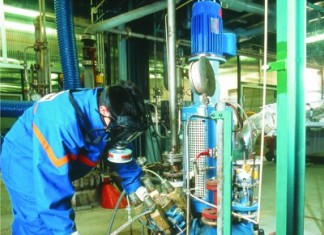PRESSURE in REFRIGERATION
Pressure is defined as force per unit of area. This is normally expressed in pounds per square inch (psi). Simply stated, when a 1-lb weight rests on an area of 1 square inch (1 in2), the pressure exerted downward is 1 psi. Similarly, when a 100-lb weight rests on a 1-in2 area, 100 psi of pressure is exerted, Figure 1. If the 100-lb weight rested on a surface that was 100 in2, the pressure exerted would be 1 psi.
When you swim under the surface of the water, you feel a pressure pushing inward on your body. This pressure is the result of the weight of the water and is very real. You would feel a different sensation when flying in an airplane without a pressurized cabin. Your body would be subjected to less pressure instead of more, yet you would still feel uncomfortable. It is easy to understand why the discomfort under water exists, the weight of the water pushes in. In the airplane, the situation is just the reverse. There is less pressure high in the air than down on the ground. The pressure is greater inside your body and is pushing out. Water weighs 62.4 pounds per cubic foot (lb/ft3). A cubic foot (7.48 gal) exerts a downward pressure of 62.4 lb/ft2 when in actual cube shape, Figure 2. How much weight is then resting on 1 in2? The answer is simply calculated. The bottom of the cube has an area of 144 in2 (12 in. * 12 in.) sharing the weight. Each square inch has a total pressure of 0.433 lb (62.4 / 144) resting on it. Thus, the pressure at the bottom of the cube is 0.433 psi, Figure 3.




A volume of 1 ft3 is equivalent to 1728 in3 (12 inches * 12 inches * 12 inches = 1728 in3), so the dimensions of the container can be changed as long as the volume remains the same. If the same 1 ft3 of water had the shape shown in
Figure 1.19 (24 inches * 24 inches * 3 inches = 1728 in3), the pressure at the bottom would be different. The area at the bottom would be 576 in2, since the base is 24 in. by 24 in. (24 in. * 24 in. = 576 in2). The resulting pressure would then be only 0.108 psi (62.4 / 576). As the base gets larger, the pressure it exerts in the downward direction gets lower. Have you ever seen someone walking across the snow wearing snowshoes? The purpose of the snowshoes is to increase the size of the base to lower the pressure pushing down. This reduces the chance of sinking into the snow.
Copied from REFRIGERATION & AIR CONDITIONING TECHNOLOGY by WILLIAM C. WHITMAN, WILLIAM M. JOHNSON, JOHN A. TOMCZYK and EUGENE SILBERSTEIN









